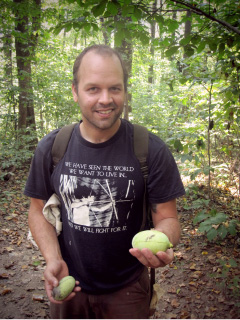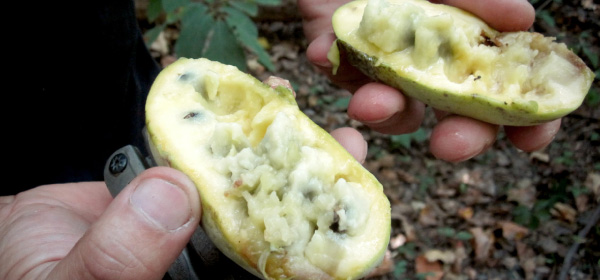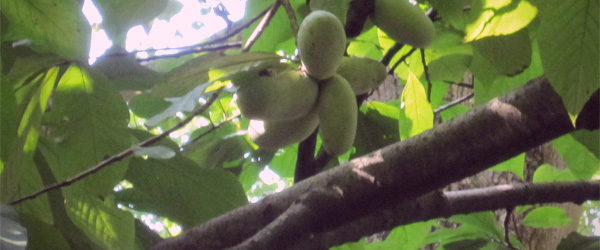 photos and story by Lee StabertI’ve watched enough Survivor to know that building a fire is hard. Or at least it should be. But then I witnessed Casey Spacht start one in less than a minute—a couple quick strokes with a string bow and some delicate blowing was all it took for the carefully prepared tinder to explode into flames.
photos and story by Lee StabertI’ve watched enough Survivor to know that building a fire is hard. Or at least it should be. But then I witnessed Casey Spacht start one in less than a minute—a couple quick strokes with a string bow and some delicate blowing was all it took for the carefully prepared tinder to explode into flames.
The wood was from a pawpaw tree, bearers of our main target for my second round of foraging in Lancaster County. The spring morel hunting trip had been so successful that I was looking forward to seeing what this new season could offer. Spacht, director of Lancaster Farm Fresh Co-op and wild foods guru, was again my guide.
On that April expedition, Spacht had pointed out the plum-colored pawpaw flowers, and promised that when the weather turned cool we could march through the forest like kings, plucking fruit left and right—discarding that which did not please us. Crouched on the forest floor, hoping to spot the slightest glimmer of that telltale morel texture, the idea seemed impossible.
But then on a hot day in September, within two minutes of entering the woods, I stepped on my first pawpaw. Shortly after, an oblong green orb about the size of a baseball almost fell on my head. He was right—they were everywhere.
Spacht plucked a “Susquehanna Banana” from the ground and cut it lengthwise, exposing the soft yellow flesh. He took one half for himself and passed the other my way. It was time for my first bite. With a texture similar to bananas, but a tartness and complexity lacking in so many commercial fruits, the pawpaw was downright delicious. And spitting the large black seeds as we walked among the trees was an added boon.
As my basket filled with fruit—many of them found on the forest floor, others shaken down from branches heavy with their burden—Spacht expounded on some other fall treasures: nuts, roots (this is the time of year when all of a plant’s energy and goodness heads south) and autumn berries, including the bright red gems of the spice tree.
In addition to combing the forest for pawpaws and other edible treats, Spacht had something else planned—the aforementioned fire. He wanted to show me the multiple uses of the pawpaw tree; the wood is an ideal texture for generating flame-starting friction.
He had also brought along a cache of hickory nuts, a small pot, some spring water from his property and a small jar of homemade maple syrup. (Spacht taps trees whenever he sees them; it takes 15 gallons of sap to make one gallon of maple syrup.) He asked me to help with the nuts, pulling two perfectly shaped stones from his bag of wonders. While he prepped the fire, I sat cracking nuts, indulging my inner Neanderthal and exposing the walnut-like flesh.
Spacht is a maestro—it took less than 20 seconds of work with a makeshift bow to produce an ember. Then it was simply a matter of transplanting the tiny coal to a nest of dried grass, leaves and dryer lint (recycling!). With a transfixing tenderness, Spacht coaxed the flame to life, gently blowing onto the precious bundle until he was engulfed in smoke and the tinder was a rage of orange licks. The fire was moved to a prepared pyramid of sticks, and the pot of hickory nuts (covered with water) went on the heat.
Boiling the nuts causes the shells to sink and the meat to rise to the top. The liquid takes on their rich, earthy flavor, and with the addition of the maple syrup, it became a cold weather beverage that put hot cocoa to shame.
Walking back to my car, I surveyed my bounty: a plethora of pawpaws, burdock root (I’ve been advised to slice and sauté; Spacht nabbed the leaves to make a salve for burns), a large chicken-of-the-woods mushroom (a beautiful pinkish shelf fungus), sassafras root (for making tea) and a large handful of chestnuts.
When I was in elementary school, there was a large chestnut tree near our playground. We would collect the urchin-like orbs, carefully prying them open to expose the pristine brown nuts inside. These treasures became trophies—rubbed between palms and stowed away in desks. I don’t think we ever thought about the fact that this was food, that snacks could come directly from a tree and not just the lunch line display.
I plan on roasting my chestnuts with a little sea salt. Maybe I’ll even serve them with some pawpaw pudding—an idea I have germinating in my head. ■+


Spacht writes about his personal foraging efforts at lancasterfarmacy.blogspot.com.



Pawpaw's are seriously the best. I always look forward to taking fall hikes and stumbling across these hidden gems. They're possibly one of my favorite fruits, although maybe I feel this way because I so rarely get to eat them.
Pawpaw's are seriously the best. I always look forward to taking fall hikes and stumbling across these hidden gems. They're possibly one of my favorite fruits, although maybe I feel this way because I so rarely get to eat them.
Where's the link to the fire starting footage?
Where's the link to the fire starting footage?
Added to the post. Thanks for the heads up.
Added to the post. Thanks for the heads up.